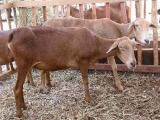
|
Morada Nova sheepThe Morada Nova comes from northeast Brazil and is probably of African origin. It may also be related to a Portugal breed called Bordaleiro. The breed originated from selection of individuals of the Brazilian Woolless. Both sexes are polled. |
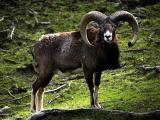
|
Mouflon sheepThe Mouflon is thought to be one of the two ancestors for all modern sheep breeds. It is red-brown with a dark back-stripe, light colored saddle patch and underparts. The males are horned and the females are horned or polled. |
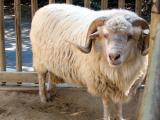
|
Navajo Churro sheepThe Navajo-Churro was the first domesticated sheep introduced into North America. Brought from Southern Spain in 1514, Churro sheep became the mainstay of Spanish ranches and villages along the Rio Grande. |

|
New Mexico Dahl sheepNew Mexico Dahl Sheep are an almost extinct Spanish Colonial heritage hair sheep breed under development at Terra Patre Wildlife Preserve & Teaching Farm in Colorado and New Mexico. The goal in developing these unique sheep is to produce a truly multi-marketable, low-maintenance product. These hardy, no-shear sheep are beautiful and majestic with the rams supporting magnificent horns. They are also very excellent sources of lean, less muttony tasting meat. |
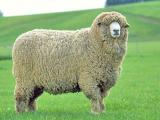
|
New Zealand Halfbred sheepThe New Zealand Halfbred is a registered breed of sheep, originally developed in the 19th century by crossing one of the English longwool breeds such as Lincoln, English Leicester, or Romney, with the Merino. |
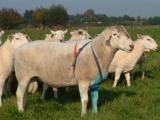
|
Nolana sheepThe breeding aim of the Nolana sheep is to combine the advantages of hair sheep with the advantages of native wool sheep. Nolana sheep are hair sheep. They don’t produce wool, but carry a smooth coat during summer and a 4-5 cm (1.6-1.8 in) thick pelt during winter which they shed naturally in spring. Therefore, they don’t need to be shorn. |

|
Norfolk Horn sheepThe Norfolk Horn originated in Norfolk, Suffolk and Cambridge, England. It is one of the ancient "Heath" breeds now being revived in small numbers. The Norfolk Horn was used along with Southdown in the development of the Suffolk breed. |
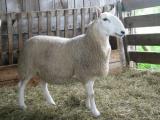
|
North Country Cheviot sheepNorth Country Cheviots are a "hill breed" of sheep. They evolved on the rugged Scotch highlands and of necessity had to thrive unattended by man and search for food on wild unimproved land. In these conditions the ewes usually lambed alone, and the newborn lambs survived by their near-miraculous ability to get-up, nurse, and run just minutes after their birth. |

|
North of England Mule sheepThis medium- sized crossbred sheep, sired by the Bluefaced Leicester, has a Swaledale or Northumberland type Blackface dam. The latter two breeds are born and reared on the Northern fells and moors and noted for their qualities of hardiness, thriftiness, and longevity. The Mule ewe has the ability to produce and rear prolific crops of lambs under any system. |

|
North Ronaldsay sheepThe North Ronaldsay is a small rare breed of sheep of the Northern short-tailed group of breeds. They have remained virtually unchanged. Their most unique feature is their diet, which consists mostly of seaweed. Mature ewes rarely exceed 25 kg (55 lbs); rams about 30 to 35 kg (66-77 lbs.). The animals are primitive and fine-boned and have evolved in a specialized seashore environment on their native island. |

|
Old Norwegian sheepThe Old Norwegian Sheep is a small primitive type of sheep which inhabited Norway and the rest of Scandinavia as well, including Iceland and Faeroes. Probably only the feral Soay Sheep of St. Kilda are more primitive. The sheep are small framed, with good legs and a fleece varying in colour from almost white to greyish, dark brown, badger-faced, muflon pattern and black. |

|
Ossimi sheepThe Ossimi breed originated in the Ossim village in the Giza Governorate of Egypt and is the most popular among the Nile and Delta sheep breeds. It is thought to be expanding its range at the expense of other breeds. |
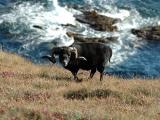
|
Ouessant sheepThe Ouessant is one of the smallest sheep breeds in the world. They originated on Ile d'Ouessant, a small island off the coast of Brittany, France. |

|
Oxford sheepThe Oxford or "Oxford Down," originated in Oxford County, England. The breed was the result of crossing Cotswolds and Hampshires. It has been contented that very early in the development of the Oxford breed, a small amount of Southdown blood was introduced. The breed has never become prominent outside of its own native area in England. Oxfords have been exported to many major sheep countries. |

|
Painted Desert sheepThe Painted Desert Sheep is a spotted hair sheep that received most of its influence from the Mouflon. Before being established as a separate breed, it was considered by many to be a parti-colored Corsican. Other early influence came from Merino and Rambouillet, and a few four-horned individuals stem from Jacob or Churro ancestry. Long desired by hunters because of the large horns and aesthetic, flashy looks, the Painted Desert is now popular among exotic and alternative livestock fanciers. |

|
Panama sheepThe Panama breed of sheep is one of only two recognized breeds of sheep which were developed in the United States by private sheep breeders. Originating in Idaho in the early 1900's, the Panama began as a cross between Rambouillet rams and Lincoln ewes. Following approximately five years of crossbreeding, rams and ewes were mated among themselves to establish the breed. |
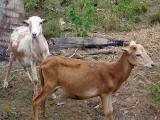
|
Pelibüey sheepThe Pelibüey is a hair sheep, probably closely related to the West African, Red African, African or Africana breed of Columbia and Venezuela. It is descended from the West African Dwarf and is found in Cuba, coastal areas of Mexico, and other locales in the Caribbean. It comprises 75 percent of sheep population in Cuba. |

|
Perendale sheepThe Perendale was developed in New Zealand during the 1950's at Massey University to meet the needs of hill country farmers on developing country. It is still a very popular breed in New Zealand. Developed from the Cheviot and Romney, the Perendale is a dual-purpose sheep producing a 28-32 micron wool with a 125 mm (5 in) staple length. |
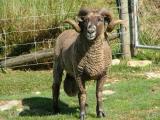
|
Pitt Island sheepThe Chatham Islands, inhabited by about 50 people, lie about 750 kilometers (469 miles) east of the Mainland of New Zealand. In 1841, Saxony Merino sheep were introduced to the Island. They have been untended for about 80 years. Natural selection has resulted in self-shedding fleeces and natural parasite resistance. Originally, they were all white. Half were black by 1950. |
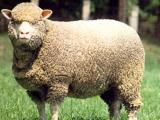
|
Polish Merino sheepThe first Merino sheep were introduced to Poland from Spain in 1786. In the early 19th centural, Electoral Merinos were imported. After 1860, Merinos of the Rambouillet and Precoce types were brought to Poland, and work towards a dual-purpose type of sheep was begun. In the period between 1918 and 1939, the breed was improved for meat traits using such breeds as the Mele and Ile de France, created on the basis of English Longwool sheep. |
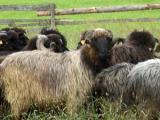
|
Polish Mountain sheepPolish Mountain Sheep evolved from the old Carpathian Cakiel, and especially one of its varieties - the primative Podhale sheep. The breed can be found in the whole Polish part of the Carpathian mountains; however, it is most frequently found in the Podhale region near the town of Nowy Sacz, where the breed traditionally originates. It has a light build, thin but strong legs and narrow rump. |

|
Polwarth sheepThe Polwarth is a dual-purpose sheep, developed in Victoria, Australia, in 1880. It is 75 percent Merino and 25 percent Lincoln. Polwarths are well suited to areas with improved pastures and are mainly found in the higher rainfall districts of southern Australia. The breed has been successfully exported to many countries, particularly South America where they are know as "Ideals". |

|
Polypay sheepThe Polypay is a synthetic breed, developed in the 1970's at the U.S. Sheep Experiment Station in Dubois, Idaho, and Nicholas Farms at Sonoma, California. Targhee x Dorset and Rambouillet x Finnsheep crosses were mated to form a 4-breed composite that could produce two lamb crops and one wool crop per year. |

|
Pomeranian Coarsewool sheepThe Pomeranian Coarsewool is a landrace sheep that used to be kept in small flocks along the Baltic Sea in Pomeranian (Pomerania) and Mecklenburg for its wool, meat, and milk. The Pomeranian are highly resistant against parasites. They are not fussy eaters, thrive on sandy, as well as moory ground and can be kept alone or in small flocks. They attach themselves to people, are hardy and not demanding. |
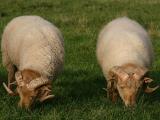
|
Portland sheepThe Portland, once common in Dorset, is now one of England's rarest breeds. It is most likely that the Portland is all that is left of the Western Tanfaced horn, common in the Southwest during the Middle Ages.The Portland was one of the breeds used in the development of the Dorset breed. Portlands are small. They are free of wool on the face and lower legs, which are tan. |

|
Priangan sheepIn the Priangan residency of West Java which includes the five districts of Bandung, Garut, Sumedang, Ciamis and Tasikmalaya, there is a breed of sheep which has been developed primarily for ram fighting (Ketangkasan Seni Domba). The rams are selected for size, horn size, and for fighting ability. The champion rams are highly priced and may fetch up to 300,000 rupiah (US$ 1 = 415 rupiah). However, they are not used for breeding during their fighting career as it is feared that mating would deprive them of their taste for fighting. |
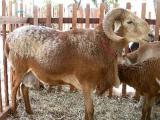
|
Rabo Largo sheepRabo Largo, meaning broad tail, are found in northeastern Brazil. They originated from fat-tailed hair breeds which were brought from Africa and crossed with the native Crioulo. |
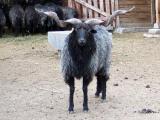
|
Racka sheepThe Racka is a unique breed with both ewes and rams possessing long spiral shaped horns. The breed is of the Zackel type and originated in Hungary. The breed is used for milk, wool and meat production. Mature males may have horns as long as two feet or more. The minimum standard length is given as 50 cm (20 inches) for rams and 30 cm (12-15 inches) for ewes. |
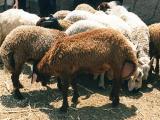
|
Rahmani sheepThe Rahmani originated in northern Syria and northern Turkey and was introduced into Egypt in the 9th century. The original stock is the Red Karman from Turkey. The breed is named after Rahmania, a village in the Beheira Governorate in the North of the Delta. |
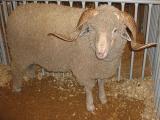
|
Rambouillet sheepThe Rambouillet is the "backbone" of the American Sheep Industry, forming the foundation of most western range flocks and raised throughout the United States. The Rambouillet descends entirely from the Spanish Merino. In fact, it is the French version of the Merino developed when Louis XVI imported 386 Spanish Merinos in 1786 for his estate at Rambouillet. |
| 1 | 2 | 3 | 4 | 5 | 6 | 7 | 8 |